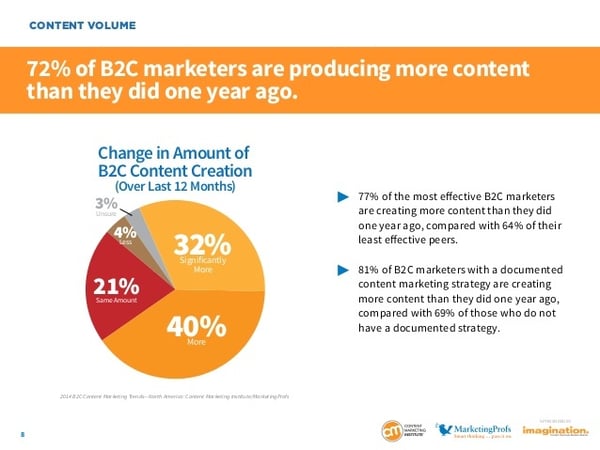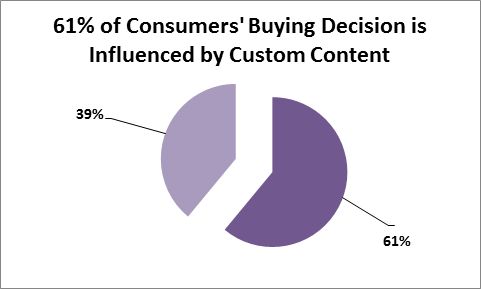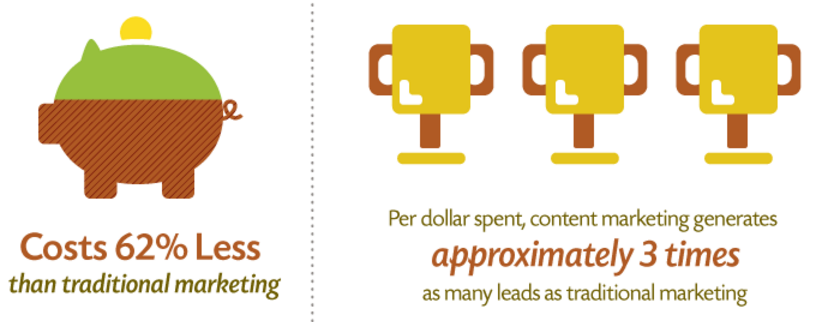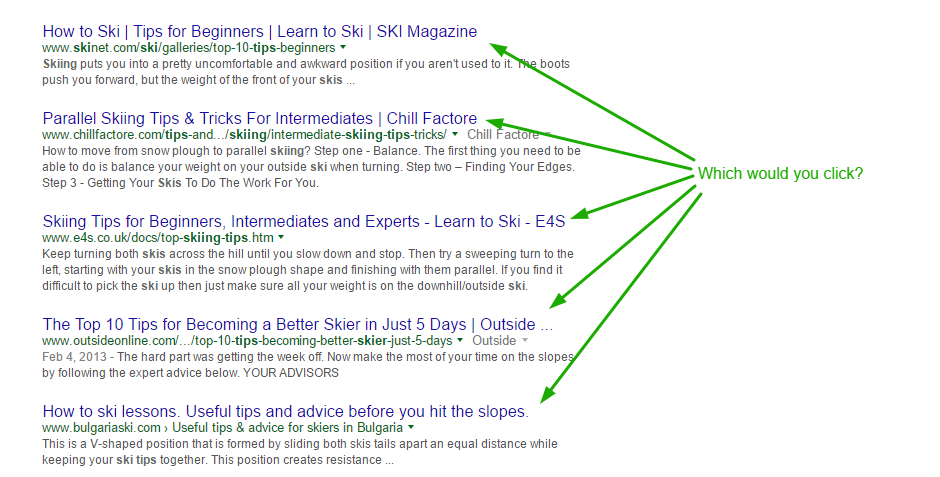
Over the past couple of years, content marketing has exploded and become a bit of a buzzword in the marketing industry. As blogging and social media have grown, businesses have started seeing the benefits and need for creating valuable content to share with their target audience. Once it became clear that content was the key, companies started producing a lot more of it.
A 2014 study from Content Marketing Institute found that 72% of B2C marketers produced more content that they did the previous year.

As interest in content marketing grew, businesses started to try to draw a line between content marketing and SEO.
And this is where the problem comes in. Businesses, and even some marketers, began to see SEO and content marketing as two separate tactics. However, the reality is they’re connected. An effective SEO strategy involves content marketing, and content marketing will impact your SEO.
At its most basic level, content marketing is creating and distributing valuable content in order to grab the attention of your target audience. Content marketing can be done in several different forms:
Here’s why content marketing has become a necessity. The way consumers shop has changed drastically due to the internet. Sales aren’t made in stores anymore. Most consumers (especially millennials) have developed the habit of doing research online before they make any purchases.
By the time they step into a store or talk to a sales rep, they already know what they want. They don’t need a salesperson to tell them the specs or convince them to buy something. That work has already been done.
On top of that, there’s a new piece of the pie that consumers are impacted by, and that’s brand trust. Custom Content Council found that 61% of consumers are influenced by custom content.

This isn’t a coincidence. Content helps consumers get to know, like and trust the companies they buy from. If a customer doesn’t trust your brand, they won’t buy from you. Just ask Chipotle.
Content marketing is the answer to any business owner who’s wondering how to reach their audience online.
Here’s the biggest mistake companies make when it comes to content marketing. They assume it’s going to get them more sales right away.
It’s true that content marketing does increase sales. However, as Moz founder Rand Fishkin points out in the video below, that process isn’t as straightforward as most businesses think.
Instead of thinking of content marketing as a way to get more sales, look at it as a way to get leads. And when it comes to generating leads, content marketing is the king. It costs 62% less than traditional marketing and generates three times as many leads.

Remember, the buying process has changed. Before you can get a sale, you need to find and nurture leads. Content marketing makes that possible.
Ok, so now that you have a good picture of what content marketing is and why you need it, how exactly does it play into SEO?
SEO is all about optimizing your site for search engines. It’s made up of two main factors.
At one point, SEO was seen as a strictly technical strategy. It was all about website structure, optimizing page load time and other factors that dealt primarily with development and data. But as content became a stronger ranking signal, the role of SEO started to gravitate towards content creators, and eventually content marketers.
SEO has become a bit more broad and in some ways less technical. Content has started to become the cornerstone of most SEO strategies instead of deep data manipulation. That doesn’t mean that technical SEO isn’t still important, but there has been a huge shift towards the more creative aspects of SEO.
As you can see, content marketing plays a significant role in both off-page and on-page factors.
For off-page SEO, content marketing helps you earn links. Whether it’s through guest blogging or creating content for your own site that you can promote, content marketing is the best form of link building.
For on-page SEO, the content you’re producing helps bring in traffic from search engines. Without content marketing, earning a variety of links organically would be very difficult for most businesses. Particularly businesses that function off-line like brick-and-mortar stores or property management companies.
Think about the average apartment community’s website. The content primarily consists of:
It’s very unlikely that other sites would want to link to any of these pages organically. But when you add a blog and write about helpful topics such as apartment decor tips, suddenly you have content that a design or apartment living blog might link to. As you create more content and attract more links, search engines see your site as more authoritative and your rankings will improve.
The “old school” approach to content creation was all about trying to please search engines. That meant doing potentially spammy things like including your target keyword throughout your content as much as possible and cranking out as many articles as you could (regardless of quality). For years, that line of thinking lead marketers to create keyword stuffed articles that weren’t very valuable or high quality.
After Google released its Panda algorithm update, a lot of low-quality sites with content built strictly for search engines saw their rankings (and subsequently traffic) wither away.
The reason behind this is Google wants to make sure the websites it displays to searches offer value. In order to meet that standard, you need to write for people first, not robots.
That means taking the focus away from strictly writing keyword-focused content. Instead, your goal should be to create content about specific topics, while keeping the reader in mind.
For example, take a look at this article about vegan recipes. Old school SEO-focused content would force the phrase “vegan recipes” throughout the article in order to make sure search engines were clear what keyword the author wants to rank for.
But since the author was focused on providing a valuable piece of content instead of keywords, the phrase is only mentioned twice, and only when it makes sense.
Making the switch from writing “SEO content” to topic-focused content is actually pretty simple. Once you have your main topic decided, think about what a reader looking for content on that topic would want to see.
With the vegan recipes example, the article was just a list of recipes. That’s exactly what someone searching for that topic is looking for, so the article is highly relevant and ranks on the first page of Google.
Some of the old school SEO best practices for content still apply however. For instance, keywords are still important, but the way you target them has changed. Instead of trying to force keywords into your content, use them naturally.
Don’t be concerned with using a keyword a certain number of times, and realize it’s ok to use variations of your target keyword. For instance if your main keyword was bird watching, you could also mention similar phrases like:
One area you should make a conscious effort to include your target keyword is in the meta title of your content. The meta title is the text that appears at the top of your web browser tab as well as in search results. Get more information about how meta titles are used for SEO in our article, How To Increase Your Web Traffic By Spying On The Competition.

Your meta title directly impacts content marketing and SEO. For content marketing, your meta title is what will entice people to click your article in the search results over a competitor. It needs to explain what the page is about, and be interesting enough to entice people to click.

For SEO, search bots rely on your meta title to determine what your article/page is about so it’s important that you’re including your keyword here. But try to avoid keyword stuffing. Your meta title should still be readable like any other headline.
In 2016 and beyond, content should be the main focus of any business that wants to win online. Your strategy needs to be a combination of SEO and content marketing.
Create high-quality content that builds trust and generates leads, and use SEO to help people find it. If you’re ready to see how content marketing can take your business to the next level, contact us today.
These Stories on Strategy

San Diego, CA
600 B St.
San Diego, CA 92101

Austin, TX
600 Congress Ave.
Austin TX 78701

Washington, DC
1875 Connecticut Ave NW
Washington, DC 20009
Copyright © 2024 AM Digital, LLC Terms of Service Privacy Policy
Street Address
City, ST 00000
Call us: 1-800-COMPANY
(800-000-0000)